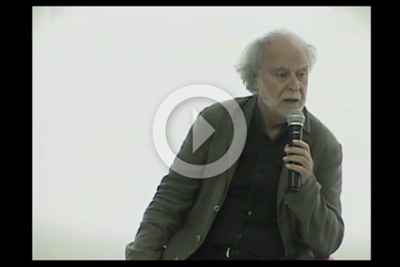The Space-Time Dimension in Digital Culture

His exposition focused on the notion of “ubiquitime,” a neologism he created to define, from an ethnographic viewpoint, “the uncentered and non-linear experiences of space-time” promoted by contemporary digital communication.
In his view, the notion of ubiquitime combines three central notions: simultaneity, “an aesthetics made of fragments from metropolises and technologies,” as advocated by Futurism, the art movement; chronotope, established by philosopher Mikhail Bahktin to denote the dialogic relationship between the spatial and the temporal horizons that “has become essential to the development of literary polyphony;” and ubiquity, a metaphor that expresses the ability to be anywhere at the same time made possible by the potential for global connection of the global digital networks.
Related materialRelated news |
|---|
Ubiquity
In Canevacci’s assessment, ubiquity is a key concept in digital culture, because it “characterizes human and non-human space-time relationships on the Internet.” He recalled that the traditional definition of the term has a theological undertone and relates to the idea of an omnipresent, invisible and inescapable godhead that observes everything and everyone: “God knows everything and will judge you,” he summarized.
The metaphorical nature of the definition proposed by Canevacci expands the threshold of ubiquity to the material world of everyday life, and extends “the presence of all human or divine beings to everywhere.”
Ubiquitous individuals can move about between different identities, spaces and times, giving rise to the multividual, according to Canevacci. The multividual emerges from the multiplication of subjectivities beyond fixed identities: “Ubiquity defies identity, which becomes more flexible. The ubiquitous subject of ethnographic experience is a multidividual.”
Empirical cases
Canevacci presented four empirical cases that exemplify the experience of ubiquitime in various cultures, starting with the Greek mythological deity Kairós, who symbolizes “a moment in an indeterminate period in which something special happens,” i.e., a propitious moment for decision or action.
Unlike Chronos, the god of chronological time, whose nature is quantitative, Kairós represents unmeasurable temporality and refers us to the idea of carpe diem – living intensely in the moment – and the power to make decisions. According to Canevacci, the concept of Kairós “does not fit restricted definitions because it is situated between two concepts: action and time, expertise and skill.”
He said that the ubiquitime dimension in Kairós refers to what he calls “methodological stupor” or “undisciplined methodological wandering” – an attitude of openness toward the unknown that enables “ethnographers to turn and move, stride and walk with abandoned slowness and attention to detail,” always willing to observe and grasp spontaneous and casual study objects.
 |
|---|
| Massimo Canevacci, IEA-USP's visiting professor |
The second case mentioned by Canevacci was the post-Euclidean architecture of Zaha Hadid. According to him, Hadid builds hybrid forms that break with the classic rules of composition and representation of space-time. “[Hadid] transforms non-normative geometry into mysterious, distorted and impure geometric shapes,” he said.
The funeral rites of the Bororo, an indigenous people studied by Canevacci, was the third empirical case presented at the conference. The rites are long and complex, and involve burying the body in a shallow ditch, waiting for the decomposition of tissues, cleaning the skull, and special ornamentation for the final farewell ceremony.
Canevacci explained that in the final stage, which lasts three days, time is suspended. “It is a period when there is time, only the celebration of the ritual that reaffirms that no distance exists between life and death, between space and time.”
The last example, also related to the Bororo, was the “multividual subjectivity” of Kléber Meritororeu, a Bororo native. For Canevacci, Meritororeu embodies the idea of the multividual because he traverses from one identity to another: he is at the same time a native who lives his culture on a daily basis and a teacher at the Indigenous State School “Sacred Heart of Jesus” in Meruri village, in the city of General Carneiro, state of Mato Grosso.
“He has two identities: he is a Bororo and teacher,” Canevacci said, stressing that Meritororeu faces the challenge not only of connecting these two identities, but also of self-representing himself with the aid of digital technologies – all this without letting go of the traditions of his people – to combine digital culture and Bororo culture.
“The use of technology by the natives helps the development of a decentralized network that cannot be compare with any analog network,” he explained. “The dichotomous relationship between technology and culture, science and arts is obsolete,” he added.
